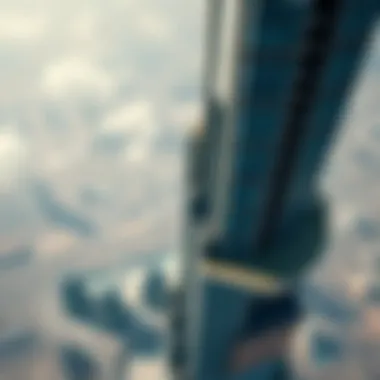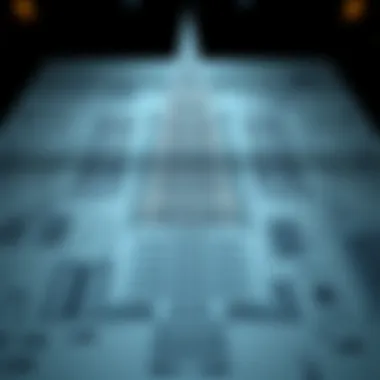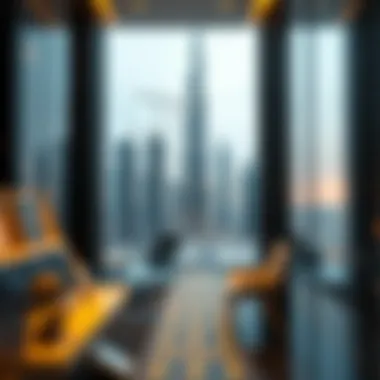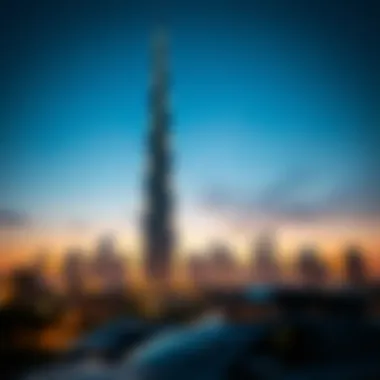In-depth Analysis of Burj Khalifa's Structure


Intro
The Burj Khalifa in Dubai stands as a testament to human ingenuity and architectural ambition. Towering at an astonishing height of 828 meters, it commands attention not just for its size but also for its intricate design and engineering precision. This iconic skyscraper has become a symbol of modernity and a beacon of Dubai’s rapid growth and transformation.
Owning a slice of real estate within Burj Khalifa has become a coveted aspiration, not only due to its prominence but also its positioning in one of the world's most vibrant cities. The structure is not merely a tall building; it's a community, combining both luxury living and commercial space under one roof. For investors, real estate agents, and enthusiasts alike, understanding the complexities of this structure is key to navigating opportunities in Dubai's competitive property market.
In the ensuing sections, we shall dissect the architectural marvel that is the Burj Khalifa. From its foundation to its pinnacle, we will explore the design philosophies, challenges of construction, and the significance of its various segments. Furthermore, we will delve into the market trends and insights related to this magnificent structure.
The Architectural Highlights of Burj Khalifa
When discussing the Burj Khalifa, it's simply impossible to overlook the architectural highlights that make this structure not just tall, but profoundly inspiring. The Burj Khalifa stands as a testament to human ingenuity and creativity, combining art and engineering like few buildings have before it. In this section, we will delve into the key design features of the building, the narrative of its creation, and the modern architectural language it has established.
Overview of the Building's Design
The design of the Burj Khalifa is a visual poem in concrete and glass, crafted by the mind of architect Adrian Smith from Skidmore, Owings & Merrill. The building rises to a dizzying height of 828 meters and features a three-lobed footprint, inspired by the Hymenocallis flower. This unique shape not only enhances its aesthetic appeal but also improves the structure's stability against the harsh winds it faces at such altitudes.
The exterior of the skyscraper is clad in reflective glass and polished stainless steel, creating an ever-changing façade under the sunlight, giving it a shimmering effect. One cannot help but notice how the tower’s design minimizes shadowing on the surrounding areas, allowing natural light to penetrate through the site. For a viewer, the Burj Khalifa appears to be a slender spire that gracefully pierces the sky, a true landmark amidst the desert backdrop of Dubai.
Inside, the layout is just as thoughtful. The lobby, with its soaring ceilings and Moroccan-inspired motifs, welcomes visitors into a world of opulence while also emphasizing functionality. The spaces are engineered to blend utility with luxury, ensuring that every floor serves its purpose while contributing to an overall sense of grandeur. From corporate offices to luxurious hotels, the Burj Khalifa truly embodies mixed-use functionality within its vertical footprint.
Significance of Height in Modern Architecture
The Burj Khalifa brings new meaning to height in the modern architectural narrative. Beyond mere numbers, its towering presence has shifted the paradigm of what buildings can represent. In a city where every inch of real estate is coveted, the height of Burj Khalifa serves as a bold statement about ambition and achievement.
Standing head and shoulders above any other structure globally, the Burj Khalifa has not only redefined skyscraper design but has also set a new benchmark for future developments. Height indicates power in the world of architecture; it suggests a social and economic status, making Burj Khalifa an emblem of Dubai’s rapid growth and its place in global culture.
"The Burj Khalifa is not just an architectural feat; it’s a national emblem reinforcing the United Arab Emirates' commitment to progressing into the future."
The architectural decisions made around the height of the Burj Khalifa have also sparked debates about urban planning and the sustainability of towering structures. With soaring heights come challenges in engineering, environmental impacts, and living conditions at such altitudes. Thus, the Burj Khalifa serves not just as a model to emulate but as a complex case study for architects and engineers looking to push boundaries while being mindful of their responsibilities.
Overall, the tall structure is a celebration—of human creativity and ambition, of the ethos that defines Dubai as a city constantly aiming for the skyline. Investing in such a monumental piece of architectural mastery represents a commitment to innovation and excellence in building design.
Understanding the Count of Floors
Understanding the count of floors in a skyscraper like Burj Khalifa goes beyond mere numbers; it’s a critical reflection of the overall design and functionality of the building. The floors are not just stacked one above the other. They serve various purposes that complement the tower's architectural identity and cater to diverse user needs. For investors and homeowners alike, recognizing the importance of each floor and its function allows for informed decisions, especially when one considers how it impacts real estate value, occupancy rates, and user experience.
Total Number of Floors
The Burj Khalifa boasts an astonishing total of 163 floors above ground, which is a staggering feat in the realm of architecture. Adding to that, there are also 2 additional floors located beneath the surface, making it a staggering observation point and living space. This extensive number of floors not only serves to elevate the tower to great heights but also enables the building to cater to a wide array of functions.
The significance of having so many floors lies in the tower's design as a mixed-use facility. Each floor is meticulously crafted to maximize the available space, featuring residential apartments, hotel rooms, offices, as well as observation decks. This vertical city concept exemplifies modern urban living and points toward a growing trend in cosmopolitan areas where space is at a premium. It’s also a glaring indicator of Dubai's ambitious aspirations, placing the emirate on the global map of architectural wonders.
Breakdown by Functionality
Delving deeper into Burj Khalifa reveals a thoughtful breakdown of functionality across its numerous floors:
- Residential Units: Approximately 900 private residences are located on levels 19 through 108. These spaces provide stunning views and luxury living to homeowners or tenants who appreciate the finer things in life.
- Corporate Offices: Floors 111 through 154 are primarily reserved for office space, designed for corporations looking to make a statement or for companies wanting to attract high-profile clients.
- Hospitality: The Armani Hotel spans levels 1-8 and also occupies parts of the 38th and 39th floors. Here, guests can experience luxury at its pinnacle, within a design conceptualized by the fashion magnate Giorgio Armani.
- Observation Decks: The iconic "At the Top" observation decks sit on the 124th and 148th floors. Offering unmatched panoramic views of Dubai, these decks are among the most frequented attractions for both tourists and locals.
This diverse functionality is what allows Burj Khalifa to embody the essence of urban living. Each floor serves as a cog in the wheel of a mega-structure that is not only an architectural marvel but also a hub of activity and interaction. The careful planning behind this structure, balancing both aesthetic grandeur and practical necessity, leaves a strong impression on anyone who considers the complexities of skyscraper environments.
As you can see, understanding the count of floors is crucial; it provides profound insights into how Burj Khalifa operates and the overall strategy behind its monumental success in a rapidly evolving urban landscape.
"The Burj Khalifa epitomizes not only the possibilities of engineering but the intricate weaving of functional spaces within a single, towering fulcrum."
For further reading:
- Wikipedia on Burj Khalifa
- Britannica article on Dubai
- Reddit discussion on skyscraper design
- Dubai Government's official tourism page
The Engineering Behind Burj Khalifa
The engineering excellence of Burj Khalifa is not just a testament to human ingenuity but also a reflection of the spirit of innovation that Dubai embodies. Standing as the tallest building in the world since its completion, the structure represents a convergence of cutting-edge technology and architectural brilliance. Understanding the engineering behind it is crucial for anyone interested in modern architecture, urban development, and the complexities of constructing monumental towers.
Innovative Construction Techniques
When it came to erecting the Burj Khalifa, its engineers employed a slew of innovative construction techniques that were groundbreaking at the time. One of the standout methods was the use of a high-performance concrete mix, which allowed the structure to grow to impressive heights while maintaining stability. The decision to use concrete over steel was a smart one — it not only facilitated construction but also minimized the weight of the building.


During the construction phase, a unique method known as the "jumping formwork" was utilized. This technique allowed the structure to be built upwards incrementally, providing both efficiency and safety for workers. As each floor was completed, the formwork would be lifted and reused for the next level, which reduced material waste significantly while speeding up the construction process.
Moreover, Burj Khalifa's architectural design incorporated a buttressed core system. This method provided unparalleled lateral support, crucial in a region prone to high winds. The three wings of the building funnel winds away from the structure, ensuring both aesthetic appeal and functional resilience.
Materials Used in Construction
The selection of materials in the construction of the Burj Khalifa was no less important than the techniques employed. Throughout the building process, approximately 103,000 square meters of glass were installed, contributing to the tower's iconic reflective façade. This glass, specially manufactured for optimal thermal performance, helps to regulate internal temperatures, reducing energy costs.
Additionally, around 15,500 tons of structural steel were used, providing phenomenal strength while minimizing weight. The use of special reinforced concrete played a critical role as well; this reinforced material can withstand the pressure and weight of such a towering structure.
Among the aesthetic materials used, aluminum and stainless steel were selected for the decorative elements, ensuring durability while enhancing the building's striking appearance. The polished finish of these materials reflects sunlight based on the time of day, giving the Burj Khalifa a unique visual character that changes from dawn to dusk.
Architects and engineers also made environmentally conscious choices by implementing sustainable practices throughout the project. Features such as high-efficiency mechanical systems and integrated water conservation methods underscore the commitment to creating a building that not only stands as an architectural icon but also respects the environment.
In summation, the engineering feats that led to the creation of Burj Khalifa are intricate, remarkable, and reflective of a collaborative effort among a diverse group of professionals. From the innovative methods employed during construction to the strategic choice of materials, every element of the tower speaks volumes about the future of modern architecture and infrastructure.
The Role of Burj Khalifa in Dubai's Economy
Burj Khalifa stands as a monumental emblem of Dubai's rapid growth and economic ambition. Its stature is not just a showcase of architectural prowess; it plays a pivotal role in shaping the economic landscape of the region. By examining its influence on various facets, one can better appreciate how this marvel has integrated itself into the fabric of Dubai's economy.
Impact on Real Estate Values
The presence of Burj Khalifa has a significant impact on real estate values in the surrounding areas. Properties with proximity to this towering structure tend to see a noticeable increase in their desirability. This trend can be attributed to several reasons:
- Prestige and Status: Owning a property near the tallest building in the world correlates with an upscale lifestyle and often signifies social stature.
- Investment Potential: Investors view areas near Burj Khalifa as gold mines for potential return on investment due to the continuous inflow of visitors and business activity.
- Architectural Value: The iconic design and sheer height of Burj Khalifa lend an appeal that boosts the aesthetic value of nearby properties.
In recent years, properties in Downtown Dubai—where Burj Khalifa is located—have witnessed some of the highest price points, making the area synonymous with luxury real estate markets. According to real estate experts, the proximity to such a landmark can elevate property prices by as much as 20-30% over comparable structures.
Tourism and Business Opportunities
Burj Khalifa is not just a stunning sight; it's an engine driving Dubai's tourism and commerce. The influx of tourists seeking to marvel at the panoramic views from the observation decks directly stimulates several sectors:
- Visitor Numbers: The tower attracts millions of tourists yearly, with many visiting specifically to access the observation decks on the 124th and 148th floors. This massive footfall boosts local businesses ranging from restaurants to retail outlets.
- Corporate Rendezvous: Given its stature, Burj Khalifa serves as a prime location for corporate meetings and events, making it an ideal space for networking within a luxurious setting. Companies often utilize conference facilities within the tower to impress clients and guests.
- Hospitality Sector Growth: The surrounding area, bustling with hotels and leisure facilities, hinges on the traffic generated by Burj Khalifa. This feeds the hospitality industry, creating thousands of jobs and fueling economic growth.
In short, the economic implications of Burj Khalifa stretch far beyond its structural achievements. The tower has woven itself into the very spirit of Dubai, elevating real estate values and fostering an environment ripe for business and tourism. As Dubai continues to evolve, the Burj Khalifa will undoubtedly remain at the forefront, symbolizing both ambition and achievement.
Visitor Experience in Burj Khalifa
The visitor experience at Burj Khalifa plays a vital role in understanding the skyscraper's cultural significance and its status as a global attraction. This structure is not just an architectural feat; it's a destination that offers unique insights into Dubai's heart and soul. Tourists and locals alike flock to this towering giant for a variety of reasons, from breathtaking views to luxurious amenities.
At the Top Observation Deck
One of the highlights of a visit to Burj Khalifa is undoubtedly the At the Top observation deck, located on the 148th floor. Standing at 555 meters, it is one of the highest observation decks in the world. Upon arrival, guests are greeted with panoramic vistas of the city that stretch as far as the eye can see. From this elevated vantage point, the landscapes unfold like a tapestry, showcasing not only the sprawling cityscape but also the surrounding desert and ocean.
Benefits of Visiting the Observation Deck:
- Spectacular Views: The sheer height of the observation deck allows for stunning visual experiences that change with the time of day, offering a totally new perspective during sunset and nighttime.
- Interactive Experiences: Visitors can enjoy touchscreen monitors providing detailed information about prominent landmarks visible from the deck.
- Photographic Opportunities: Ample photo spots to capture momentous memories in one of the world's most recognizable buildings.
"Reaching the top of the Burj Khalifa is akin to touching the sky and witnessing the world from a vantage point only a few experience."
Access to the At the Top experience is carefully managed, with timed tickets ensuring that the visitor flow remains smooth. This ensures a manageable crowd, which enhances the experience rather than detracts from it. Guests also have the opportunity to purchase special tickets that include experiences like guided tours, providing an enriched understanding of the building's history and architecture.
Amenities and Attractions
Beyond the stunning views, the amenities located within Burj Khalifa significantly enhance the visitor experience. These offerings range from fine dining to cafes, ensuring that guests can enjoy more than just the sights.
Key Attractions Include:
- Dining: The building hosts several high-end restaurants, including Atmosphere, which is renowned for its culinary excellence. Dining here is a feast for both the palate and the eyes, with vista views that complement the gastronomic experience.
- Art Installations: As part of the building's innovative architecture, various art installations are strategically placed throughout, adding an artistic layer to the experience. Each piece tells its own story, contributing to the cultural fabric of Dubai.
- The Dubai Fountain: Located at the base of Burj Khalifa, this captivating fountain show draws visitors with its choreographed performances of water, music, and light, adding another dimension to the overall visit.
The visitor experience at Burj Khalifa is crafted thoughtfully, ensuring that it resonates with diverse audiences, from tourists eager for unforgettable memories to expatriates seeking a taste of local culture. This engagement goes far beyond merely witnessing an architectural marvel; it immerses visitors in an exploration of the lifestyle, culinary arts, and artistic endeavors that Dubai embodies.
The Symbolism of Burj Khalifa
Burj Khalifa stands tall not just as a feat of engineering but also embodies the spirit and aspirations of Dubai. Within its towering structure lies a rich tapestry of cultural significance and representations of the city's vision. This segment explores the profound symbolism encapsulated in the iconic skyscraper, shedding light on its importance in Dubai's identity and its wider impact on the world.


Cultural Significance
In the cultural landscape of the United Arab Emirates, Burj Khalifa is more than a landmark; it acts as a powerful symbol of progress. The tower's design draws inspiration from traditional Islamic architecture while integrating modern elements, which shows a deep respect for the region's heritage. Each tier of the building reflects age-old minaret structures, transforming a familiar architectural language into something verging on the celestial. This union of past and present fosters a sense of pride among Dubai's residents and provides a visual anchor in their rapidly modernizing environment.
Furthermore, the Burj has become a canvas for artistic expression. Each New Year’s Eve, it serves as the backdrop for fireworks that light up the sky, attracting millions. This yearly celebration has not only boosted its cultural importance but also turned it into a ritual that signifies hope and renewal. Locals and tourists alike see these displays as a rallying point to gather and share in experiences that foster community spirit, all under the gleaming record-holder of height.
Representation of Dubai's Vision
Burj Khalifa arises from a vision to brand Dubai as a global city, setting benchmarks in architecture and urban planning. It signifies aspirations that go beyond mere construction; it’s a monument attesting to human creativity and perseverance. Dubai's leadership aimed to position the emirate as a global hub for tourism, commerce, and trade, and the Burj Khalifa stands as a statement of this ambition.
The tower's sleek, minimalist design—crafted by the renowned architect Adrian Smith of Skidmore, Owings & Merrill—exemplifies not just innovation but also Dubai’s commitment to sustainability. The structure's implementation of advanced energy efficiency initiatives illustrates how the city strives for modernity while being cognizant of environmental stewardship.
Comparison with Other Skyscrapers
When examining Burj Khalifa, it's crucial to contextualize its prominence within the broader landscape of skyscrapers. Each towering structure tells its own story, molding the character of its city and representing the ambitions of its builders. By comparing Burj Khalifa to its notable counterparts, one can grasp not just the architectural techniques, but also the cultural significance and economic impacts of these titans of steel and glass.
Burj Khalifa vs. Shanghai Tower
Burj Khalifa stands tall at 828 meters, making it the tallest building in the world since its completion in 2010. However, its crown has been under potential threat from the Shanghai Tower, which rises to 632 meters. This comparison sheds light on both buildings’ unique architectural philosophies and cultural implications.
- Design Elements: The Burj Khalifa’s design is inspired by Islamic architecture, incorporating patterns and motifs that resonate with the Middle Eastern heritage. On the flip side, the Shanghai Tower’s twisting form mimics the dynamics of Chinese culture, offering an aesthetic that reflects growth and sustainability.
- Height and Functionality: While both structures boast impressive heights, Burj Khalifa contains more floors—163, as opposed to Shanghai Tower’s 128. This multi-level design caters to various purposes from luxury living to corporate offices.
- Technology & Sustainability: Shanghai Tower takes a lead in sustainable technology. Its design incorporates wind turbines and solar panels, making it a forerunner in energy efficiency. In contrast, Burj Khalifa utilizes the latest innovations in air conditioning and water recycling, emphasizing luxury and comfort but perhaps less attention to ecological impact.
"Both of these architectural marvels embody the spirit of their cities, showcasing the innovation and aspirations of a rapidly evolving global landscape."
When put under the microscope, the difference in climates, cultures, and priorities is glaring. For investors and expatriates, understanding the nuances between Burj Khalifa and Shanghai Tower can inform decisions about investment opportunities, whether in luxury apartments or commercial properties.
Burj Khalifa vs. One World Trade Center
Shifting focus to the USA, One World Trade Center in New York represents resilience and renewal post-9/11, standing at 541 meters, a significant yet shorter contender when side by side with Burj Khalifa. Evaluating their contrasts and similarities provides insights into distinct architectural identities.
- Symbolism: Where Burj Khalifa symbolizes the opulence and modernity of the Middle East, One World Trade Center embodies hope and resilience. It stands as a tribute to those lost, making its narrative both personal and communal.
- Design and Structure: Burj Khalifa is characterized by its sleek, tapering silhouette and distinct Y-shaped floor plan, optimized for wind-load and reducing sway. In contrast, One World Trade Center has a more robust, boxy appearance, with a prism-like crown reflecting the skyline.
- Cultural Impact: Each tower serves as a beacon in its respective city. While Burj Khalifa has bolstered Dubai’s image on the world stage as a luxury destination, One World Trade Center is a poignant reminder of the resilient spirit of New Yorkers.
Comparing these structures isn't merely about height or floor count; it’s about what they signify to their people, their economies, and their places on the global stage. With each skyscraper, we see not just visionary engineering but also architectural dialogues that shape the identity of cities and cultures.
Investors and future homeowners who comprehend these buildings' significance can better appreciate the nuances underlying real estate choices. Understanding not only the structures but what they embody can guide them through a complex landscape of opportunities and considerations.
Future Prospects for Burj Khalifa
The Burj Khalifa is not just a structure; it stands as a symbol of Dubai's ambition and foresight in modern architecture. Looking ahead, the future prospects of this iconic tower hold significance that stretches beyond its immediate allure. As with any grand masterpiece, the focus turns not only to maintaining its majesty but also to enhancing its relevance in a continually evolving landscape. Investors and enthusiasts alike must take heed of the ongoing maintenance, potential upgrades, and surrounding developments that could either elevate or diminish the Burj's stature.
Ongoing Maintenance and Upgrades
Owning a building of Burj Khalifa's grade comes with its own set of responsibilities. The ongoing maintenance is not merely an afterthought; it's essential to preserve the structural integrity and aesthetic appeal that attracts millions of visitors each year. To keep the facade glimmering in the desert sun, regular cleaning is required, with specialized teams descending from the top to scrub away dust from the cladding.
Moreover, the mechanical and electrical systems demand constant oversight to ensure efficient functioning. Heating, ventilation, and air conditioning systems, along with advanced elevators, need regular evaluations and updates. Here's what ongoing maintenance involves:
- Facade Maintenance: Specialized teams handle the cleaning and upkeep of the glass exterior, particularly critical given Dubai’s harsh climate.
- Mechanical Checks: Routine evaluations of HVAC and elevator systems are done to guarantee they run smoothly.
- Safety Inspections: Regular inspections for fire safety features and emergency exits are paramount, maintaining a safe environment for visitors and residents.
As technology advances, upgrades become necessary. Implementing smart building technology can drastically enhance energy efficiency, making Burj Khalifa more sustainable while reducing operational costs.
Potential Developments in Surrounding Areas
If the Burj Khalifa is the leading actor, its surroundings are the supporting cast that can enhance its narrative. The areas surrounding the tower are ripe for development, presenting opportunities to further integrate the structure into Dubai’s urban fabric. Conversations about future developments often include several possibilities:
- New Commercial Spaces: Plans for shopping complexes or business hubs are in the cards, offering visitors and residents more amenities close to the tower.
- Public Parks and Green Spaces: Integrating green elements can attract families and provide a scenic backdrop for photographs against the Burj Khalifa.
- Transport Accessibility: Enhancements to public transport and road infrastructure that facilitate improved access to the tower can bolster visitor numbers.
Such developments enhance the allure of Burj Khalifa, solidifying its position as a must-visit landmark. A thriving surrounding area could result in increased foot traffic and, in turn, better commercial success for businesses in the vicinity.
"The Burj Khalifa serves not only its own purpose but also acts as a catalyst for growth in Dubai's vibrant economic landscape."
As we embrace the future, it’s clear that the prospects for Burj Khalifa depend not just on its individual might but also the interconnectedness of the urban environment that cradles it. Investors and homeowners must stay tuned to these developments, as they signal the continuing evolution of this iconic structure.
The Environmental Impact of Burj Khalifa
The Burj Khalifa is not merely a stunning architectural feat basking in the Dubai skyline; it also stands as a testament to modern engineering's commitment to sustainability and environmental responsibility. Understanding its environmental impact is an essential aspect of analyzing the building, showcasing how tall structures can balance awe-inspiring design with ecological mindfulness. This section explores significant elements, benefits, and considerations regarding the environmental footprint of the Burj Khalifa.


Sustainability Initiatives
The designers and builders of the Burj Khalifa put considerable thought into sustainability initiatives that aimed to minimize its ecological impact. Some key initiatives that are worth noting include:
- Water Recycling Systems: The building employs an innovative system that collects and recycles water, which is then used for landscaping and other non-potable purposes. This practice reduces wastage and conserves precious water resources in a desert environment where every drop counts.
- Solar Panels: The structure features solar panels that contribute to its energy needs. While they may not supply a large portion of the building's energy, every bit helps in reducing reliance on non-renewable sources.
- Green Spaces: The landscaping around the Burj Khalifa supports biodiversity. Native plants are chosen to ensure that the landscaping requires minimal irrigation. This helps maintain a natural habitat and reduces water consumption in irrigation.
These sustainability initiatives not only help keep the Burj Khalifa on the greener side but also reflect a commitment to eco-friendly practices that set an example for future skyscrapers.
Energy Efficiency in the Building
Energy efficiency is crucial when assessing the environmental impact of any skyscraper, and the Burj Khalifa has made strides in this respect. The building features several energy-efficient technologies that collectively contribute to a reduced carbon footprint:
- Advanced Insulation Systems: The walls are built using high-performance, thermally efficient insulation materials. This helps maintain comfortable indoor temperatures, reducing the need for extensive heating and cooling.
- Energy Management Systems: Cutting-edge energy management systems are integrated into the building's infrastructure, allowing for real-time monitoring and control of energy consumption. This technology helps identify areas for improvement and optimizes energy usage across the board.
- Efficient Lighting: Inside the Burj Khalifa, LED lighting systems illuminate the expansive floors. These lights consume significantly less energy compared to traditional lighting and offer longer lifespans, further minimizing energy waste.
Incorporating these energy-efficient practices not only lowers the operational costs for the owners but enhances the overall sustainability profile of the Burj Khalifa.
"Eco-friendly skyscrapers are not merely structures of glass and steel but embodiments of a sustainable vision for urban living."
For further reading on urban sustainability and skyscraper designs, you can visit Britannica or explore discussions on platforms like Reddit.
Architectural Competitions and Awards
The world of architecture is not only about structures but also about recognition and prestige. In this context, competitions and awards serve a dual purpose: they inspire innovation and push the boundaries of what's possible while also crowning the triumphs of those who excel in their craft. When it comes to Burj Khalifa, its accomplishments in architectural competitions are paramount to its identity, illustrating its uniqueness and brilliance as a skyscraper.
The numerous accolades it has garnered reflect not just its physical stature but also its thoughtful design and construction. Awards in architecture often highlight aspects like sustainability, aesthetic appeal, and engineering prowess, and Burj Khalifa has made its mark on all these fronts. Notably, being recognized by esteemed organizations solidifies its status in the architectural world, influencing trends and setting benchmarks for future projects.
Recognition in the Architectural Community
Burj Khalifa’s recognition extends far beyond mere height; it is a testament to human ingenuity and ambition. The Council on Tall Buildings and Urban Habitat (CTBUH) declared it the tallest building in the world upon its completion in 2010, a title that comes with not just admiration but also a reevaluation of architectural possibilities. Awards like the Tall Buildings Award reinforce its significance, shining a spotlight on the engineering capabilities that went into its construction.
Importance of Awards
- Credibility: Achieving awards lends credence to the architects and engineers involved, showcasing their expertise.
- Attractiveness: Many investors and visitors are drawn to award-winning structures like the Burj Khalifa, enhancing its economic value.
Furthermore, the accolades given to the Burj Khalifa emphasize its role in promoting sustainable practices in urban design. It has introduced energy-efficient systems that can serve as a model for future constructions.
Influence on Future Skyscraper Designs
Looking toward the horizon, Burj Khalifa's influence on future skyscrapers cannot be overlooked. Its design principles serve as both inspiration and a blueprint for green building practices. The integration of advanced technologies for energy conservation has changed how architects approach high-rise buildings.
Key Influences
- Verticality: The elegant yet bold vertical lines of Burj Khalifa have led many designers to rethink their approach to height and aesthetics, promoting a trend toward sleek and slender structures.
- Mixed-Use Developments: With its diverse functional spaces – from residential to corporate, and leisure – the Burj Khalifa showcases the efficacy of mixed-use developments. This approach has been emulated in various other skyscrapers across the globe.
In short, Burj Khalifa not only stands tall as an architectural wonder but also as a catalyst for transforming future designs and encouraging sustainable practices in the industry. Its impact reverberates through the architectural community, shaping the way cities will evolve in the coming years.
End: The Legacy of Burj Khalifa
The Burj Khalifa stands as more than a mere skyscraper; it is a testament to human ingenuity and ambition. This iconic structure encapsulates the spirit of modern engineering, showcasing advancements that have shifted the paradigms of what is possible in architecture and construction. As we dissect the layers of its significance, it’s evident that the Burj Khalifa has left an indelible mark not just on Dubai, but on the architectural world at large.
Many regard the Burj Khalifa as the pinnacle of human achievement. Its towering height of 828 meters challenges designers and engineers to rethink urban landscapes. This structure has become an enduring symbol for Dubai’s rapid growth and transformation, reflecting the city’s ambition and resilience. Investors, homeowners, and expatriates focus on this monument, seeing it not only as a physical manifestation of luxury but also as a marker of economic vitality.
Enduring Icon of Modern Engineering
When considering the Burj Khalifa's place in history, one cannot ignore its engineering marvels. The building is designed to withstand the desert winds and seismic activities that could otherwise compromise its structural integrity. The buttressed core design is groundbreaking; it combines design efficiency with aesthetic appeal. This method allows the building to soar higher without compromising on safety or stability.
"The Burj Khalifa is not just the tallest building; it’s an evolving narrative of engineering excellence and architectural boldness."
This makes it a reference point for engineers worldwide, who now look to this structure for inspiration when designing future skyscrapers. Its success set a high bar and challenged architects and city planners to envision new icons for urban spaces.
Continuing Influence on Dubai's Urban Landscape
The Burj Khalifa doesn’t only redefine the skyline of Dubai; it has a profound influence on the urban planning and development strategies within the region. As one of the foremost landmarks of the Downtown Dubai area, it acts as the nucleus around which other notable developments have encircled.
- Real Estate Boom: Properties surrounding the Burj Khalifa, like those in the Dubai Mall and the surrounding residential areas, have seen escalating values. Investors look favorably upon these opportunities, recognizing Burj Khalifa’s role in driving market demand.
- Urban Design: The building's presence catalyzes infrastructural improvements and transit accessibility, compelling other cities to adopt similar planning methodologies. From transport to public spaces, the influence extends well beyond just the visual appeal.
In summary, the Burj Khalifa's legacy will continue to shape Dubai and influence urban landscapes globally. Investors can see that it creates not just opportunities within its physical expanse, but also inspires a broader vision for future developments.'
For more insights on Dubai’s architectural feats and investment opportunities, consider exploring these resources:
- Wikipedia: Burj Khalifa
- Britannica: Burj Khalifa Overview
- Real Estate Opportunities in Dubai
- Urban Design Strategies
The Burj Khalifa may one day evolve into more than just an architectural masterpiece, perhaps embodying community space or sustainable living options as a nod to the future. Whatever lies ahead, it is clear that its legacy is secured in the annals of modern history.











